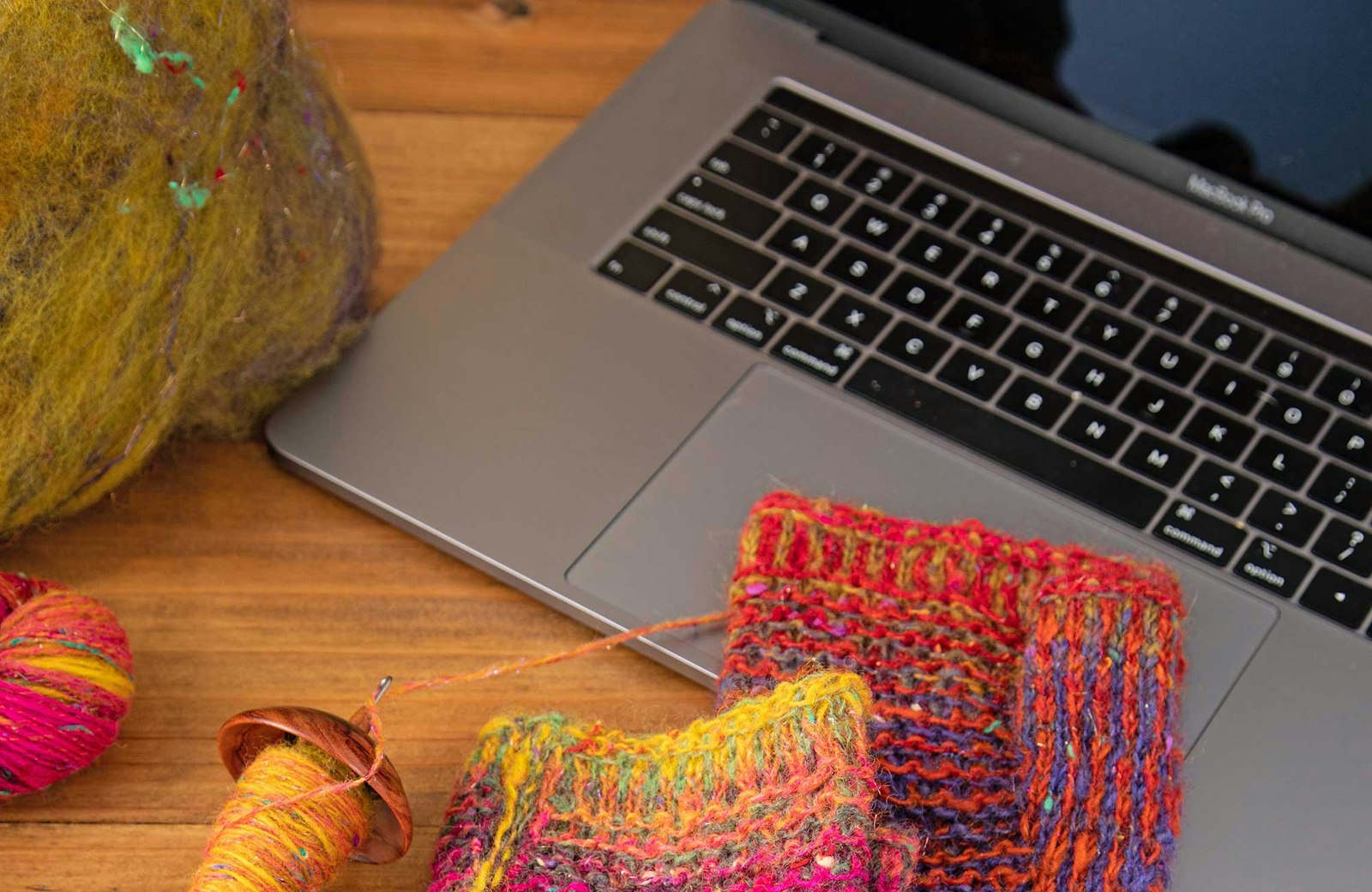Whether it's the heat, weather, cold, or wind, it's nice to have an indoor activity to look forward to, especially when there's knitting (and cute sheep) involved. Sure, I like to pick up my knitting needles or paintbrush or sit down at the spinning wheel when I’m looking for indoor activities. But, let’s face it, there are times when we just feel like reclining with remote in hand and binge-watching a favorite series. My recent watch: A Twist on Color.
How is Yarn Made?
I’m always fascinated to read about—or especially watch—the process of going from shearing the sheep to having finished yarn in hand. Episode 1 introduces us to farmer Lisa Westra, who raises Bluefaced Leicester in northern Maryland. Watch as she leads us through the 13 steps—13!—of making her farm yarn at Feederbrook Farm, from dyeing the combed top from her flock that’s right outside the door, to spinning and plying, to making the skeins.
 Yarn being spun at Feederbrook Farm. Photo by Pamela Schultz
Yarn being spun at Feederbrook Farm. Photo by Pamela Schultz
In Episode 2, Lisa talks us through how she prepares her booth at a busy fiber festival, where knitters line up to purchase her signature line of barber pole yarn, Entropy. Lisa also explains how her colorways are random, yet repeatable, originally developed with her handspun and duplicated in the mill.
How Can I Choose Colors with Confidence?
Yarn store owner Jenny Monteleone collaborates with Lisa, creating designs with Feederbrook Farm’s beautiful self-striping, color-shifting yarn. Jenny helps customers at Lisa’s fiber-fest booths confidently select colors for their project. In Episode 3, Jenny breaks down self-striping yarn and why people may be a little afraid of it when they start working with it. I learned how the “color runs” in a skein—the length of one color before it changes to another—affect the finished project. Is the color run random or repetitive and organized? My takeaway from Jenny: if you have a busy yarn, pick a simpler pattern. She shows several finished examples of longer color runs vs. shorter and how stripes might become narrower with a particular project, depending on whether you’re knitting small mittens or large blankets.
 Jenny Monteleone gives tips on working with color-shifting yarns. Photo by Matt Graves
Jenny Monteleone gives tips on working with color-shifting yarns. Photo by Matt Graves
In Episode 4, Jenny conveys how she has learned how crucial it is to do swatching—and why to save your swatches. If you’ve fallen in love with a yarn and want to work with it again, you’ve already done the work and can refer back to your swatch. Huh. I’ve never really thought of that. Afraid of color-shifting yarns turning into a muddy colorway? Make lots of swatches! Jenny shares several tips for swatching, gleaned from her years as a yarn-store owner and knitting teacher, which are great for those of us who may at times default to shortcuts when it comes to swatching.
With each episode, there are additional resources, so you’ll find yourself going down a rabbit hole with so much extra content.
A Mighty Flock
Now that I’ve made it all the way through A Twist on Color, I plan to sit down next weekend and revisit The Yarn Chronicles. My favorite part of Episode 1 is watching all of the footage of shepherdess Tammy White of Wing & A Prayer Farm in Vermont roaming her property with her sheep in tow. Throughout the episode, Tammy describes how she started with a few small Shetland sheep and has grown her mixed flock to between 75 and 100, how she turned her hobby farm into a production farm, and how buying yarn from small farms such as hers helps support other small businesses as well.
Watch the full episode of The Yarn Chronicles, Episode 1 here!
A Shearer and a Designer Weigh In
In Episode 2, professional shearer Siri Swanson sits down to discuss how she got into shearing, what it takes to travel and handle a flock, and why this hard job is taxing on the shearer’s body so that it’s easier on the sheep. I love watching what shearing day is like at Wing & A Prayer Farm and I learn so much from watching how volunteers sort the fleece for making yarn.
 Siri Swanson shears a sheep. Image from The Yarn Chronicles
Siri Swanson shears a sheep. Image from The Yarn Chronicles
Episode 3 sits down with the owners of Battenkill Fibers Mary Jeanne Packer and Angela Bennett, who give us a behind-the-scenes tour of the workings of their mill. And we hear from Norah Gaughan and other knitwear designers in Episode 4, who share how they select yarns to work with and how those yarns connect them to the animals and farms.
 Norah Gaughan helps skirt a fleece at Wing & A Prayer Farm. Image from The Yarn Chronicles
Norah Gaughan helps skirt a fleece at Wing & A Prayer Farm. Image from The Yarn Chronicles
This summer, I hope you will find some time to relax with a cold drink in hand and one of these series queued up on your laptop.
Cheers!
–Debbie

